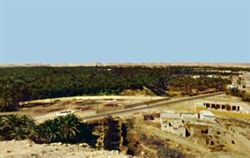
The Egyptian word for oasis, wh3t, appears in texts from as early as the Old Kingdom, and under Pepi I and II there were even governors appointed to these areas. According to the Egyptians, there were seven oases - Kharga, Dakhla, Farafra, one between Farafra and Bahriya, Bahriya itself, the Wadi Natrun and Siwa. Numerous remains of temples, forts, villages and cemeteries in the oases in the western desert have yet to be excavated.
The oases supplied grapes and dates and were also important links in the trade routes to more remote areas. There are indications that during the Middle and New Kingdoms, people fleeing persecution went to the oases of Kharga and Dakhla, and during the 21st Dynasty they were havens for political exiles.
Siwa oasis is famous for the failed attempt by Cambyses to conquer it in 525 BC, and for the visit by Alexander the Great to consult the oracle of Amun. The town of Hibis lay in Kharga Oasis and was an important transport and trade centre. Hibis is mainly famous for its temple of Amun, the only temple from the period 1100-300 BC that has been preserved.